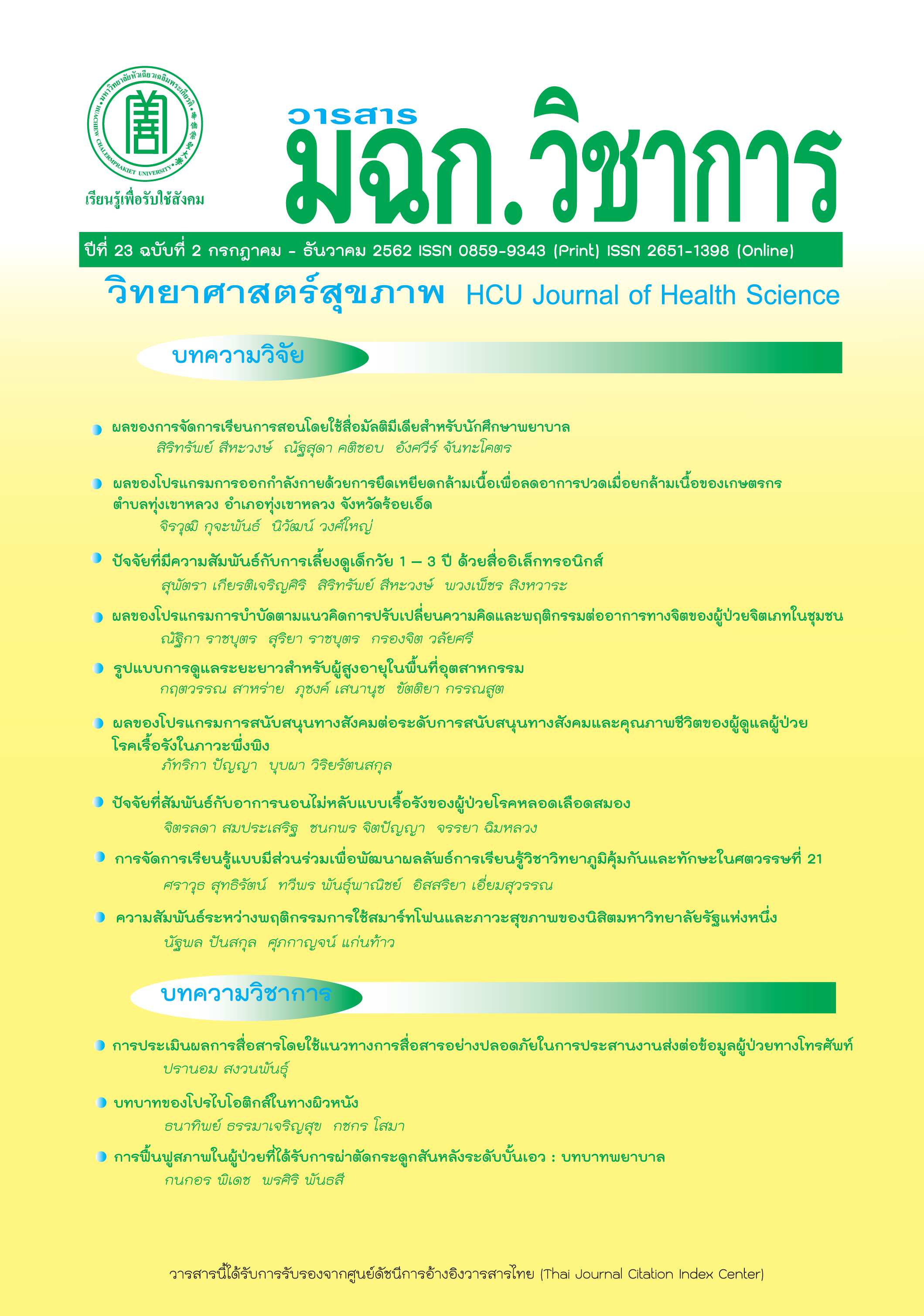Rehabilitation in Patients with Lumbar Spine Surgery : Nurse’s Role
Keywords:
Rehabilitation, Lumbar spine surgeryAbstract
Lumbar spine surgery were treatment for repair of spinal cord compression. And keep the stability of spine. Prevent increase in the Spondylolisthesis. Pathology of surgery has affect to the patient's daily routine. If they were not properly behavior post surgery. That cause subsequent complications. Rehabilitation after surgery was important for patients to have knowledge and skill of self-care. Especially for the functional ability to do physical activity, which is necessary for daily activities. Returning to work or occupation. For the role of the nurse, it will be necessary to encourage patients to have a comprehensive physical and mental rehabilitation. Including appropriate in rehabilitation phase. For patients to rehabilitate quickly. Reduce complications after surgery. It also reduces the length of hospital stay as well.
Downloads
References
2. กระทรวงสาธารณสุข กรมการแพทย์. รายงานสถิติโรค พ.ศ. 2554. นนทบุรี: ศูนย์เทคโนโลยีสารสนเทศและการสื่อสาร กรมการแพทย์; 2554.
3. กรมการแพทย์ สถาบันประสาทวิทยา. แนวทางการพยาบาลผู้ป่วยผ่าตัดกระดูกสันหลังสำหรับพยาบาลทั่วไป. ธนาเพรส; 2561.
4. Ploumis A, Tranfledt E, Denis F. Degenerative lumbar scoliosis associated with spinal stenosis. Spine. 2007;7:428-36.
5. ต่อพงษ์ บุญมาประเสริฐ. Spinal surgery (การผ่าตัดโรคกระดูกสันหลัง) [อินเทอร์เน็ต]. [เข้าถึงเมื่อ 23 พฤศจิกายน 2561]. เข้าถึงจาก:http: //www.med.cmu.ac.th/hospital/nis/download/ spine2011/spinal_surgery.pdf
6. Abbott D, Tyni-Lenne R, Hedlund R. Early rehabilitation targeting cognition, behavior, and motor function after lumbar fusion: a randomized controlled trial. Spine. 2010;35(8):848-57.
7. นลินี พสุคันธภัค, วาริณี ด้วงเงิน. ผลของการจัดท่าขึ้นและลงจากเตียงกับความเจ็บปวดสำหรับผู้ป่วยผ่าตัดกระดูกสันหลังส่วนหลังและเอวหลังผ่าตัดวันที่สอง. วารสารกองการพยาบาล. 2553;37(2):77-96.
8. Den J, Oostendorp R. Continued disability and pain after lumbar disc surgery. Pain. 2016; 123:45-52.
9. นันทยา เสนีย์. ผลของโปรแกรมส่งเสริมการรับรู้สมรรถนะแห่งตนต่อพฤติกรรมการฟื้นฟูสภาพของผู้ป่วยกระดูกขาหักที่ได้รับการผ่าตัดใส่โลหะยึดตรึงภายใน [วิทยานิพนธ์]. กรุงเทพมหานคร: จุฬาลงกรณ์มหาวิทยาลัย; 2554.
10. Nielsen R, Jorgensen D, Dahl B, Pedersen T, Tonnesen H. Prehabilitation and early rehabilitation after spinal surgery: randomized clinical trial. Clin Rehabil. 2010;24(2):137-148.
11. Allvin R, Ehnfors M, Rawal N, Idvall E. Experiences of the postoperative recovery process: An interview study. The Open Nursing Journal. 2018;2:1-7.
12. ชนิภา ยอยืนยง, ผ่องศรี ศรีมรกต. ปัจจัยทำนายการฟื้นตัวด้านความสามารถในการทำหน้าที่ของร่างกายในผู้ป่วยที่ได้รับการผ่าตัดกระดูกสันหลังส่วนเอว. วารสารพยาบาลทหารบก. 2558;16(1):62-9.
13. Starkweather R, Witek-Janusek, L, Nockels P, Peterson J, Mathews L. Immune function, pain, and psychological stress in patients undergoing spinal surgery. Spine. 2016;31(18):641-7.
14. Nordin M, Welser S, Campello A, Pietrek M. Self-care techniques for acute episodes of low back pain. Best Pract & Res Clin Rheumatol. 2012;16(1):89-104.
15. กนกอร พิเดช, จิราพร เกษพิชญวัฒนา, ปชาณัฏฐ์ นันไทยทวีกุล. ผลของโปรแกรมส่งเสริมการจัดการตนเองต่อความสามารถในการทำกิจกรรมของผู้ป่วยหลังผ่าตัดกระดูกสันหลังระดับบั้นเอวในระยะฟื้นฟูสภาพ. วารสารแพทย์นาวี. 2561;45(2):267-88.
16. เสาวนิตย์ กมลวิทย์, ปิ่นอนงค์ รัตนปทุมวงศ์. การพัฒนาแนวปฏิบัติทางคลินิกด้านการจัดการความปวดในผู้ป่วยหลังผ่าตัดโรงพยาบาลระนอง. วารสารกองการพยาบาล. 2557;41(2):23-40
17. Mannion F, Denzler R, Dvorak J, Müntener M, Grob D. A randomised controlled trial of post- operative rehabilitation after surgical decompression of the lumbar spine. Eur Spine j. 2007;16(8):1101-17.
18. พีระชัย ดำรงวานิช. (2552). โรคปวดหลัง. [อินเทอร์เน็ต]. [เข้าถึงเมื่อ 10 ธันวาคม 2561]. เข้าถึงจาก: http://thaispine.tripod.com/spi_nonop.html
Downloads
Published
How to Cite
Issue
Section
License
บทความที่ได้รับการตีพิมพ์เป็นลิขสิทธิ์ของวารสารวิทยาศาสตร์สุขภาพและสุขภาวะ
ข้อความที่ปรากฏในบทความแต่ละเรื่องในวารสารวิชาการเล่มนี้เป็นความคิดเห็นส่วนตัวของผู้เขียนแต่ละท่านไม่เกี่ยวข้องกับมหาวิทยาลัยหัวเฉียวเฉลิมพระเกียรติ และคณาจารย์ท่านอื่นๆในมหาวิทยาลัยฯ แต่อย่างใด ความรับผิดชอบองค์ประกอบทั้งหมดของบทความแต่ละเรื่องเป็นของผู้เขียนแต่ละท่าน หากมีความผิดพลาดใดๆ ผู้เขียนแต่ละท่านจะรับผิดชอบบทความของตนเองแต่ผู้เดียว




